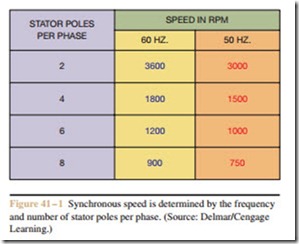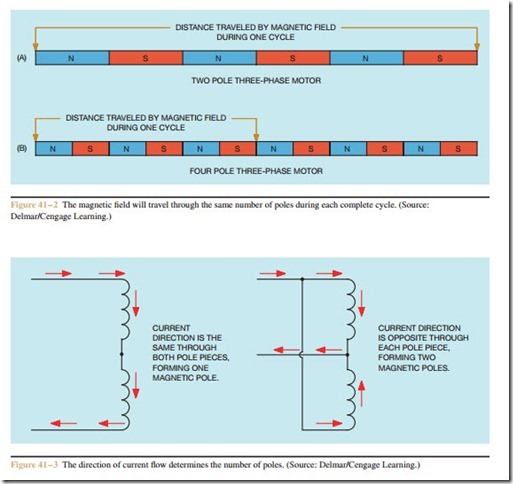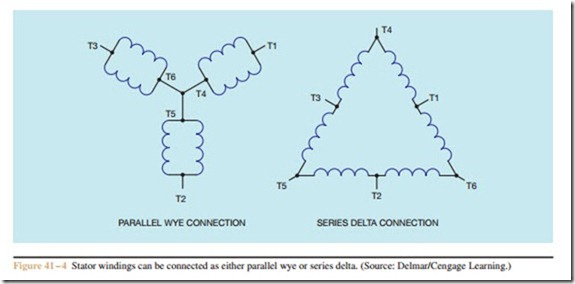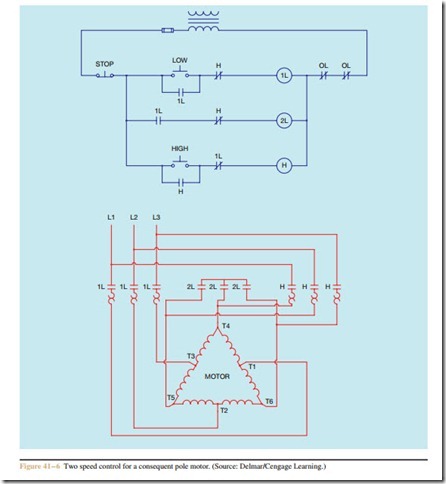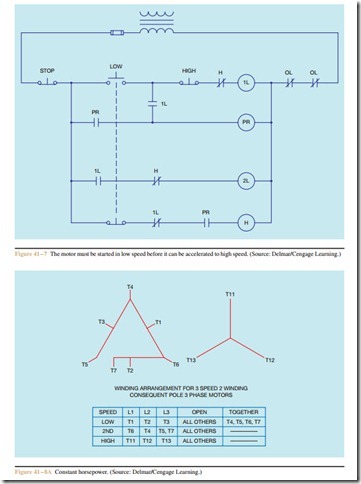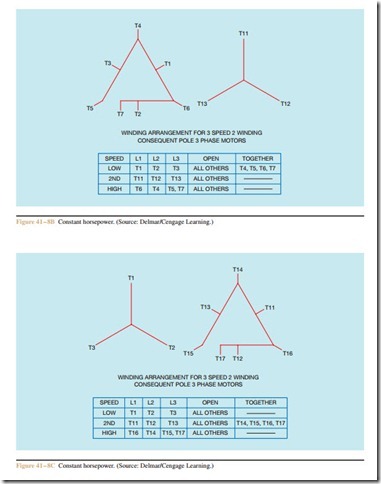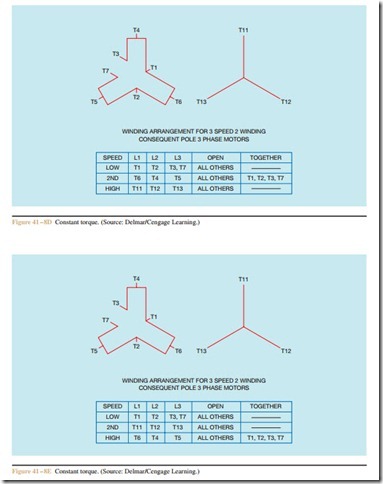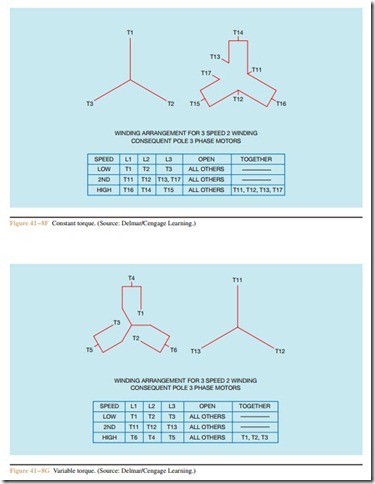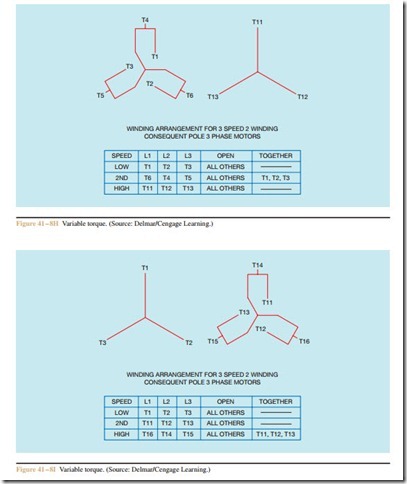Consequent pole motors have the ability to change speed by changing the number of stator poles. There are two factors that determine the synchronous speed of an AC motor:
1. Frequency of the applied voltage
2. Number of stator poles per phase
A chart showing the synchronous speed of 60 and 50 hertz motors with different numbers of poles is shown in Figure 41 – 1. A three-phase two-pole motor contains six actual poles. The magnetic field will make one revolution of a two-pole motor each complete cycle. If the stator of a motor were to be cut and laid out flat, the magnetic field would traverse the entire length in one cycle (Figure 41 – 2A). If the number of stator
poles is doubled to four per phase (Figure 41 – 2B), the magnetic field will traverse the same number of stator poles during one cycle. Since the number of poles has been doubled, the magnetic field will travel only half as far during one complete cycle. Consequent pole motors have an advantage over some others types of variable speed alternating current motors in that they maintain a high torque when speed is reduced.
The number of stator poles is changed by redirecting the current through pairs of poles (Figure 41 – 3). If the current travels in the same direction through two pole pieces, both will produce the same magnetic polarity and are essentially one pole piece. If the current direction is opposite through each pole piece, they will produce opposite magnetic polarities and are essentially two poles.
Two-speed consequent pole motors contain one reconnectable stator winding. A two-speed motor will contain six T leads in the terminal connection box. The motor can be connected to form a series delta or parallel wye (Figure 41 – 4). If the motor is wound in such a way that the series delta connection gives the high
speed and the parallel wye gives the low speed, the horsepower will be the same for either connection. If the winding is such that the series delta gives the low speed and the parallel wye gives the high speed, the torque will be the same for both speeds.
Two-speed consequent pole motors provide a speed ratio of 2:1. For example, a two-speed consequent pole motor could provide synchronous speeds of 3600 and 1800 RPM, or 1800 and 900 RPM, or 1200 and 600 RPM. The connection diagram for a two-speed consequent pole motor is shown in Figure 41 – 5. A typical controller for a two-speed motor is shown in Figure 41 – 6. Note that the low speed connection re- quires six load contacts: three to connect the L1, L2, and L3 to T1, T2, and T3; and three to short leads T4, T5, and T6 together. Although contactors with six load contacts can be obtained, it is common practice to employ a separate three-pole contactor to short T4, T5, and T6 together.
In the circuit shown in Figure 41 – 6, the Stop but- ton must be pressed before a change of speed can be made. Another control circuit is shown in Figure 41 – 7 that forces the motor to start in low speed before it can be accelerated to high speed. The Stop button does not have to be pressed before the motor can be accelerated to the second speed. A permissive relay (PR) is used to accomplish this logic. The motor can be returned to the low speed by pressing the Low push button after the motor has been accelerated to high speed. The load connections are the same as shown in Figure 41 – 6.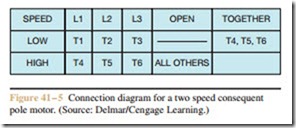
Three-Speed Consequent Pole Motors
Consequent pole motors that are intended to operate with three speeds contain two separate stator windings. One winding is reconnectable like the winding in a two- speed motor. The second winding is wound for a certain number of poles and is not reconnectable. If one stator winding were wound with six poles and the second were reconnectable for two or four poles, the motor would develop synchronous speeds of 3600 RPM, 1800 RPM, or 1200 RPM when connected to a 60 hertz line. If the re- connectable winding were to be wound for four or eight pole connection, the motor would develop synchronous speeds of 1800 RPM, 1200 RPM, or 900 RPM. Three-speed consequent pole motors can be wound to produce constant horsepower, constant torque, or variable torque. Examples of different connection diagrams for three-speed, two-winding consequent pole motors are shown in Figures 41 – 8A through 41 – 8I.
Related posts:
Incoming search terms:
- consequent pole
- what is consequent pole motor
- consequent pole method
- consequent pole winding
- consequent pole induction motor
- Consequent method of pole changing
- use of method of consequent poles
- Consiquent pole winding
- f1W8rcmko59IzJvZXMvmpS1HOjY3_s91NXuqHDl8pKw
- induction generator with consequent poles
- methods of consequents poles
- image on consequent poles
- Method of consequent poles
- method of consequent pole
- motor pole and rpm chart
- Pole changing and methods of consequent poles
- pole changing method of consequent method power constant nd torque constant
- why the number of poles is changed in 2:1 in speed control of induction motor
- what is consequent pole
- two speed motor separate winding one directional motor control
- two speed motor one winding two direction motor control
- two pole induction motor winding diagram
- three speed motor connection
- speed of one pole
- RPM motor dari pole
- If it is intended that the motor maintain constant torque for both low and high speeds the parallel wye connection will provide low speed and the series delta will provide high speed
- how many pole are there in consequence winding
- how do you delta a 6 pole motor
- concequent pole technique method
- consequence of an electric motor
- consequent induction motor
- Consequent magnetic pole
- consequent pole changing of induction motor
- consequent pole connection in three phase motor
- 3 phase consequent 6 lead motor wiring diagram
- consequent pole motor torque
- consequent pole motor torque changes
- consequent pole motor wiring
- consequent pole pic
- consequent pole principal in induction motors
- consequent poles
- consequent winding for motor
- consequient poles method of speed control of induction motor
- consquent method polechangemetho
- disadvantage of the consequent pole motor
- abstract of method of consequent poles
